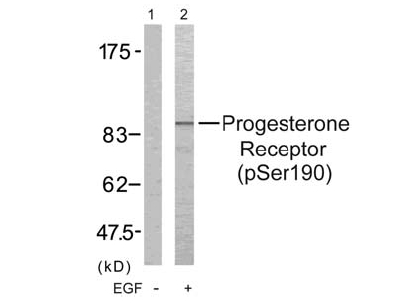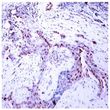Progesterone Receptor (PGR) pSer190 Rabbit Polyclonal Antibody
CAT#: AP02372PU-S
Progesterone Receptor (PGR) pSer190 rabbit polyclonal antibody, Aff - Purified
Size: 100 ul
Other products for "PGR"
Specifications
| Product Data | |
| Applications | IF, IHC, WB |
| Recommended Dilution | Western blot: 1/500-1/1000. Incubate membrane with diluted antibody in 5% nonfat milk, 1X TBS, 0,1% Tween-20 at 4°C with gentle shaking, overnight. Immunofluorescence: 1/100-1/200. Immunohistochemistry on Paraffin Sections: 1/50-1/100. |
| Reactivities | Human |
| Host | Rabbit |
| Clonality | Polyclonal |
| Immunogen | Synthetic phosphopeptide derived from Human Progesterone Receptor around the phosphorylation site of Serine 190 (G-L-Sp-P-A). |
| Specificity | This antibody detects endogenous levels of Progesterone Receptor only when phosphorylated at Serine 190. |
| Formulation | PBS (without Mg2+ and Ca2+), pH 7.4, 150 mM NaCl State: Aff - Purified State: Liquid purified Ig fraction Stabilizer: 50% Glycerol Preservative: 0.02% Sodium Azide |
| Concentration | lot specific |
| Purification | Immunoaffinity Chromatography using epitope-specific phosphopeptide. Non-phospho specific antibodies were removed by chromatogramphy using non-phosphopeptide. |
| Conjugation | Unconjugated |
| Storage | Store undiluted at 2-8°C for one month or (in aliquots) at -20°C for longer. Avoid repeated freezing and thawing. |
| Stability | Shelf life: one year from despatch. |
| Predicted Protein Size | 99 kDa |
| Gene Name | progesterone receptor |
| Database Link | |
| Background | Progesteron receptors (PRs) are nuclear hormone receptors of the NR3C class, which also inculdes mineralocorticoid, glucocorticoid and androgen receptors. They exist as homodimers coupled to Hsp90 or HMGB proteins, which are shed upon activation. The major signaling pathway used by progesterone receptors is via direct DNA binding and transcriptional regulation of target genes. They can also signal by binding to other proteins, mainly with transcription factors such as NF-kappaB, AP-1 or STAT. Progesterone receptors are found in the female reproductive tract, mammary glands, brain and pituitary fland and receptor expression is induced by estrogen. Well established functions of progesterone receptores include ovulation, implantation, mammary gland development and maintenance of pregnancy. In addition, progesterone, signaling through the progesterone receptor, increases the ventilatory response of the respiratory center to carbon dioxide and decreases arterial and alveolar PCO2 in the luteal phase of the menstrual cycle and druing pregnancy. The human gene encoding the progesterone receptor has been localized to 11q22. |
| Synonyms | PR, PGR, NR3C3 |
| Reference Data | |
Documents
| Product Manuals |
| FAQs |
| SDS |
{0} Product Review(s)
0 Product Review(s)
Submit review
Be the first one to submit a review
Product Citations
*Delivery time may vary from web posted schedule. Occasional delays may occur due to unforeseen
complexities in the preparation of your product. International customers may expect an additional 1-2 weeks
in shipping.






























































































































































































































































 Germany
Germany
 Japan
Japan
 United Kingdom
United Kingdom
 China
China





